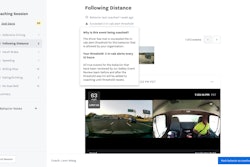If you turn the clock back 20 years ago, carriers only knew a driver was speeding if they got a ticket, and then they were disciplined upon returning to the terminal days, if not weeks, after the incident, greatly reducing the chances of correcting that driver's behavior.
Now, fleets have ELDs, dash cams, telematics devices and more providing instant data to carriers and allowing immediate feedback for drivers. But all this insight has bogged down carriers with data overload.
Register today for "Finding and Keeping Drivers in a Demand-Driven Job Market" webinar
Executives from three fleets share the driver recruiting and retention strategies that have propelled their companies to become some of the industry’s best, and how they plan to stay there. This CCJ webinar is sponsored by Bestpass.
With so many disparate sources of data, it can be impossible to prioritize which data matters.
But all metrics that drive an overall better operation come back to safety and risk management, Hayden Cardiff, Idelic founder and chief innovation officer, said during a recent Truckload Carriers Association webinar. He said carriers can make better use of their data and improve operations by consolidating driver behavioral data sets and taking action based on those to reduce risk and therefore improve operational efficiency, revenue and more.
Deploying a driver performance management program and consolidating data across all processes can help carriers narrow the focus to drive better insurance rates, more revenue, better customers, driver retention and more.
“Now, as opposed to before, we have way too much data, and I think that's coming from we, as an industry, have realized that we need technology in our cabs; we need systems that help us track this data; we need to be able to have that visibility. I think that's breeding one of the main problems and challenges that there are too many systems, too much data, too much noise,” Cardiff said. “Step one is taking all those systems and being able to tie it together.
“Integrate your ELD data, camera data, telematics, dispatch data, HR data, accident risk claims data, the FMCSA portal,” Cardiff continued. “Being able to pull all of that together and having it in one dome enables you to start doing some really important and impactful things. You need to have the KPIs and metrics and the visibility to understand what decisions to then make.”
Brian Fielkow, a board of directors member at Jetco, a GTI Company, said data for data’s sake isn’t helpful; it has to be packaged with artificial intelligence and analytics so safety and operations departments and the executive suite can align to determine a plan for how to use it to benefit the company. To ignore the data, he said, is to expose your company to risk.
And that’s because others can use that data against your company.
Fielkow said customers and prospective customers seek this data when searching out a carrier to haul its goods, and if a carrier’s data scores slip, it could knock them out of the bid list for the best opportunities; insurance companies watch this data to determine risk and rates, and plaintiffs bars use the data retroactively in the event of an accident; and current and potential employees look at this data, affecting recruitment and retention.
But where do you start?
Behavior drives data, Fielkow said, so analyzing driver data and the behavior behind that is a good focus area for carriers looking to take control of the overwhelming amount of information they receive daily because safety is at the root of overall enterprise risk management.
“A lot of people (buy into) this myth of do you want to be safe or productive – either or – that safety is somehow a drain on productivity,” he said. “The safest companies are the most productive because they’re not cleaning up the mess; they’re spending more time proactively and less time retroactively. Safety is the bellwether of an operationally excellent company.”
Cardiff said safety intersects with driver productivity and operational efficiency because lack of safety at worst can cause accidents that, at best, delays shipments, reducing productivity, but at worst results in damages that can cost a carrier millions of dollars and their reputations.
Idelic, he said, has identified driver performance management as the most effective framework to use data to identify root problems that can lead to disasters. But Cardiff said AI and machine learning are important to add to the equation so carriers can leverage it, using predictive analytics to prevent crashes and other safety failures.
Fielkow said driver data allows carriers to focus more acutely on the behavior it wants to reward, recognize and propagate on the proactive side while addressing and correcting poor behavior on the reactive side.
“The more you can use data to figure out why you're having the problem, the better you can fix it. For example, speeding. Is it one rogue driver? Terminal specific? One particular load planner putting too much pressure on drivers?” he said. “Once we start to get all that data together, what we can do as fleets is start to proactively engage and understand who to engage within our fleets.”
The data, predictive analytics and coaching mean nothing without accountability.
While data can pinpoint a specific driver, Fielkow said it’s important to engage everybody within the fleet – beyond the safety department.
He said carriers should consider combining safety and operations meetings rather than hosting them separately because everyone companywide needs to live and breathe safety. Integrating those types of meetings will build camaraderie, rapport and trust in an operation.
It also helps mitigate or eradicate any disconnects between departments, he said. For example, the safety department may preach safety while operations incentivizes drivers based on their productivity.
He said carriers need to close the loop to support the overall mission.
“You have to get rid of the safety as a department mentality. The metrics you deploy have to be owned by operations because, after all, who has their hands on the lever? Your safety professionals have a vital role to train, coach, mentor, ensure accountability, ensure compliance, but they're not the ones dispatching; they're not the ones telling a driver to get something done in eight hours that you really need 10 hours for,” Fielkow said. “Every company has silos, and they're there because we built them. If we can build them inadvertently, we can tear them down deliberately.”













